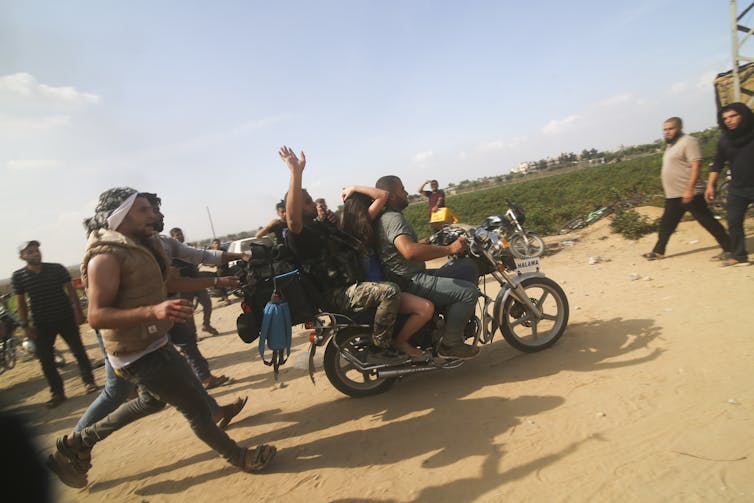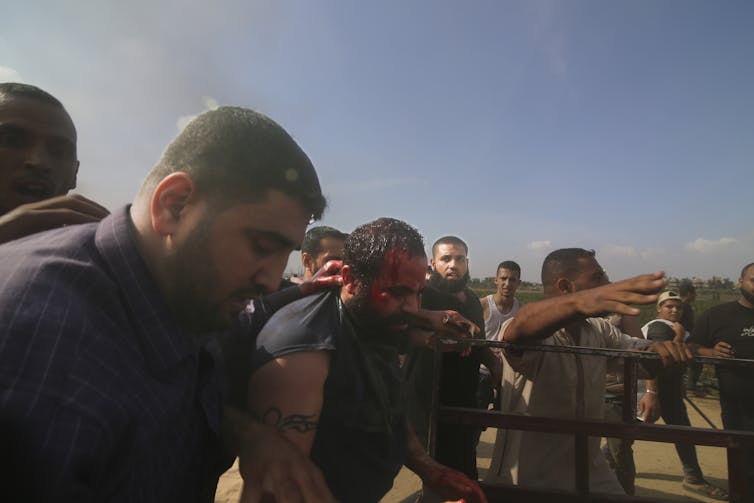Israel has no good options for dealing with Hamas’ hostage-taking in Gaza

Hamas, the Gaza-based Palestinian militant group that mounted a deadly surprise attack on Israel that has killed – at last count – at least 1,200 Israelis, has captured what are estimated to be 150 hostages. Brought back to Gaza, those hostages include children, members of the military and the elderly. Most are civilians captured from the towns bordering Gaza. President Joe Biden revealed on Oct. 10, 2023, that some are Americans. Hamas has said that every time Israel strikes a Gaza home “without warning,” a hostage will be killed, and that execution would be recorded and the recording played for the public.
The Conversation asked James Forest, a University of Massachusetts Lowell expert on international security, to help readers understand the dynamics of this hostage crisis.
The taking of hostages looks like a planned part of this Hamas operation – why would Hamas do this?
Terrorist groups have historically taken hostages to gain leverage in negotiating for policy concessions, financial ransoms or the release of imprisoned comrades, and generally to influence the decisions and behavior of the targeted government.
In this instance, Hamas has stated that its goal is about forcing Israel to release imprisoned Palestinians. Its threat to kill hostages in retaliation for unannounced attacks against Gaza is another example of attempted coercion of Israeli leaders.

Hamas also has a vulnerability that many other terrorist groups have not had – namely, a physical territory of its own that can be targeted.
Holding hostages in unknown locations throughout this territory is an attempt to prevent Israel from launching military strikes that could inadvertently kill Israeli citizens. And taking hostages could also be intended to generate morale among Hamas supporters domestically and internationally by showcasing the group’s abilities to frighten and harm a more powerful adversary.
Similar to the hostage-taking at the 1972 Munich Olympics by the Palestinian group Black September, another likely objective here is to draw international attention to the desperation of people living in blockaded, impoverished Gaza.
However, attention doesn’t necessarily lead to sympathy. Taking innocents hostage, especially children and the elderly, is condemned worldwide, and it will be hard to find sympathy for the perpetrators of such crimes even when they’re claiming to free their land from occupation. Further, when citizens of other countries – such as the U.S. – are among the hostages, Hamas will likely find this to have been a counterproductive decision because it could invite retaliation from multiple countries.
Two other strategic considerations behind this act would be provocation and spoiling. Hamas is likely drawing on classic strategy in which the terrorists try to provoke the targeted government into an overly heavy-handed response. Hamas likely wants to enrage Israel to the point that Israel begins lashing out against Palestinians with escalating brutality. This, in turn, would support the so-called spoiler strategy, by disrupting current efforts to normalize relations between Israel and Arab nations.
What choices do the Israelis have for responding?
Democratic governments face many challenges in responding to terrorist groups taking their citizens hostage. Israel cannot be seen to underreact, yet neither should it overreact.
Among the different counterterrorism strategies they could pursue, repression – including collective punishment, an approach frequently used by Israel in the past – would seek to deter Hamas from conducting further terrorist attacks, and also to raise the level of hardship among Palestinians in Gaza to a point that they rise up against Hamas. Examples of repression in response to terrorism include prohibiting free speech or public gatherings, arresting political activists without probable cause, arbitrary searches and destruction of homes, and deportations.
A July 2020 United Nations report noted: “While Israel’s justification for imposing the closure on Gaza was to contain Hamas and ensure Israel’s security, the actual impact of the closure has been the destruction of Gaza’s economy, causing immeasurable suffering to its two million inhabitants.” To date, repression has not produced the results sought by Israel.

Another strategy, referred to by scholars as “decapitation,” involves the capturing or killing of a terrorist group’s leaders.
Three important challenges come with this approach, the most important of which is locating the group’s leaders when they are being sheltered within a territory with so many tunnels – as Gaza has – and among Hamas supporters.
Second, if Israel is able to capture Hamas’ leaders, there may not be much political will on either side of this conflict to negotiate a prisoner-hostage swap, at least not while the daily carnage fuels their desire for vengeance. Third, if top commanders of Hamas are killed, there is always a chance they could be replaced with new leaders who are more brutal than the previous ones.
Finally, another option available to Israel is negotiation. In years past, government leaders have arranged for the release of Israeli hostages, including soldiers, in return for the release of imprisoned Palestinians.
However, negotiation almost never takes place in the midst of an active military confrontation. Instead, the historical pattern suggests any potential negotiations would wait until some time after the guns and rockets have gone quiet.
Hamas leaders believe a fundamental source of their perceived legitimacy is based on their ability and willingness to violently confront Israel. So the underlying challenge is that there is no hope of negotiating a lasting peace with a group that does not see peaceful coexistence as being in its best interest.
How would a hostage in this situation be treated? Do we know based on previous hostage-taking?
It’s hard to say for sure. I think it will vary according to a mix of contextual factors, like who the hostage is and who is holding them hostage.
It is likely that Hamas leaders have given orders to their units that hostages are not to be harmed, and they are to be moved around and held in various locations in hopes of deterring Israeli military strikes.
However, disciplined adherence to such commands is not always the case among terrorist groups – especially in the midst of an active military confrontation. That said, most violent groups recognize that if their hostages are killed, they will lose whatever bargaining chips they had hoped to gain.

Is there a role for intermediaries? If so, who might they be?
Finding an intermediary who is trusted by all parties will be exceedingly difficult, as trust is hard to come by in this region. And whether it’s a country with influence – like the U.S. – or an international organization, it’s likely that an opportunity for intermediaries to help arrange the return of hostages will only emerge after the active shooting, rocket attacks and air strikes have subsided.
How might the taking of these hostages affect the conduct of the war, on both sides?
Israeli forces are surely being told to try to avoid actions that could harm the hostages. Throughout this conflict, assistance from U.S. and other intelligence agencies will likely help Israel locate targets to attack and hostages to rescue. Some hostages could be found and reunited with their families.
Hamas will likely use the hostage drama to generate lasting media attention. The group’s leaders may feel that a building destroyed by a bomb will generate some photos and headlines for perhaps a few days, but posting online photos and videos each week of Israelis being held captive would garner the spotlight for Hamas much longer. In the end, both sides must tread carefully.![]()
James Forest, Professor and Director of Security Studies, School of Criminology and Justice Studies, UMass Lowell
This article is republished from The Conversation under a Creative Commons license. Read the original article.



